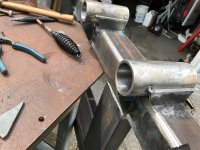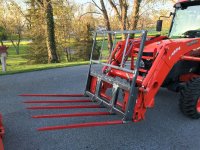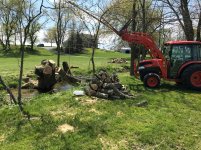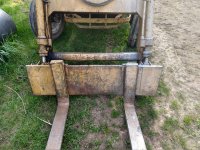Great feedback! Thank you so much.
- When I have to do this again I will try the preheat. It is a good tip. I was actually doing the opposite. I was waiting for the metal to cool down between segments.
- I will get a new ground clamp, cheap insurance.
- removing the cup, would never have thought about that.
- I did clean the metal.
- I got the job done but I as soon I get time I want to practice some these tips.
Again thanks for the help.
If you want to learn stick, you won't be disappointed, it's a challenge, and can be fun.
But it will set you back on your "repairs" timewise.
It's like saying you have to learn to chop wood with an axe before using a chainsaw.
Chopping can be useful on a stump roots for example, where the dirt will destroy your chain instantly.
If you are going to spend money, get a gas bottle for your Miller 140 and you will up your game considerably.
Miller 140 is a quality machine.
It can weld 1/4 very well, and even a little thicker with technique and pre-heat.
Focusing on MIG is a far better use of your time.
Stick welding will take a LOT of time - and until you master it, your "repairs" will be all covered with bird poop.
I'ts been what, 40years( ?) since any viable factory has used stick welding.
Its a vintage art, and has its place. If you WANT to learn it, it will certainly help, as anything, even oxy/acet gas welding, it all helps understanding.
But focusing on your MIG will get you repairing things well much faster.
It's barely worth the effort in comparison.
The only people who tell you stick welding is worth learning are those who already put in the time to learn it - and they want you to suffer too.
MUCH faster to put your study and practice time into MIG welding, you can be MIG welding in 1/10 the time maybe 1/20th.
Watch YouTubes and go practice.
Even better if you can do ^^THAT^^ and get a welder to show you some things in person.
Learn the machine you have.
PLUS, it's a Miller 140, a fine machine - that can do it well (not some POS $200 bargain unit)
Here's teaching an 18-year old to weld (making a log grate for the woodstove).
This is her first time welding with about one hour of 'assistance' ( I am NOT a pro welder ).
I bent the rebar and she welded.
Those welds are using gas (not flux-core).
The grate is in the fireplace now.
You might post a pic of the bucket you're welding, or at least tell us how wide it is or describe the tractor.
Some (large) buckets are better suited to a 220v welder.
If it's easy to get 220v where you're welding, a machine that welds on either 110v or 220v is nice to have.





